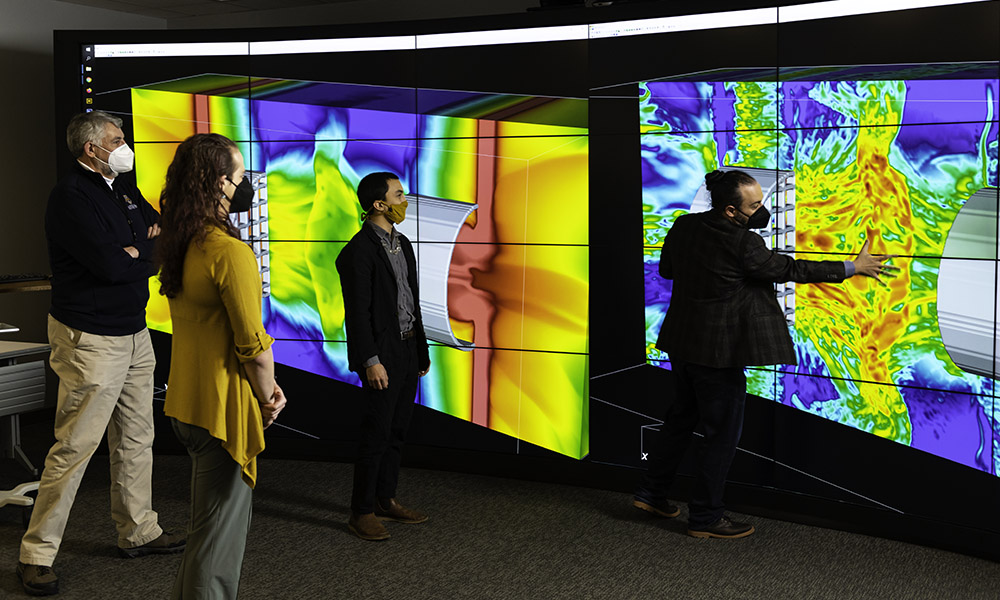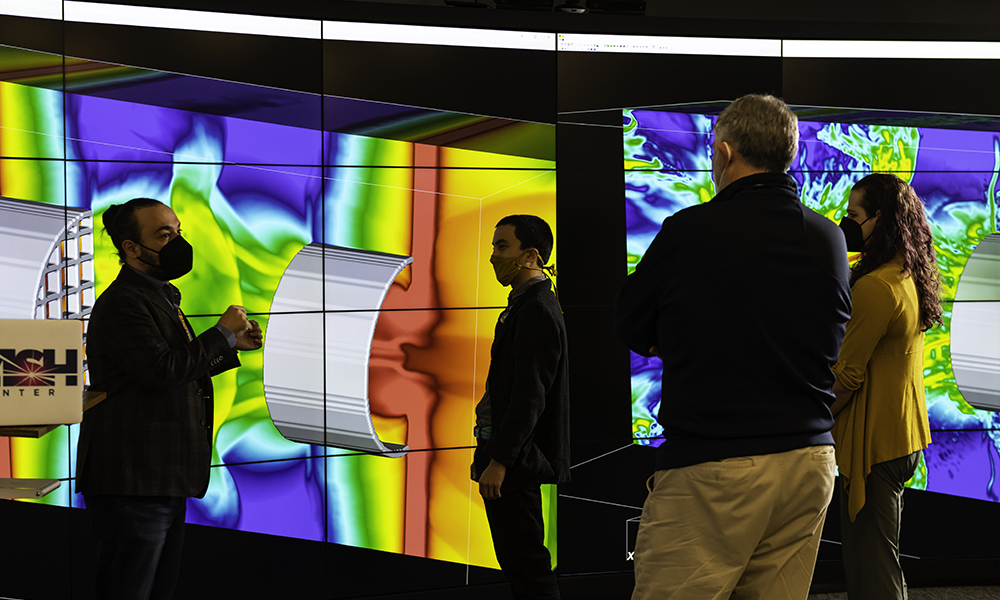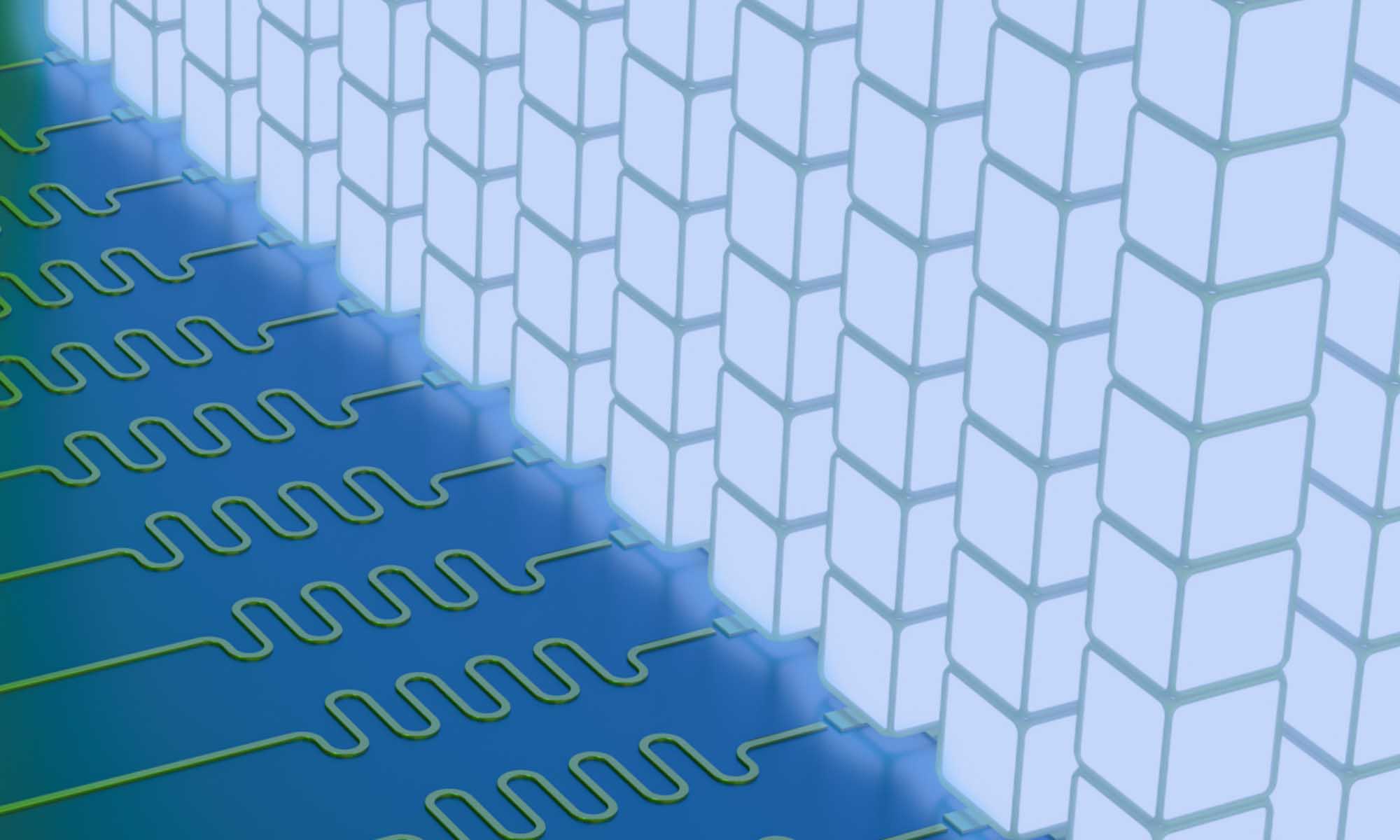Scientists from Rochester, Chicago, and Oxford have replicated for the first time in a laboratory setting conditions that exist within galaxy clusters, some of the largest known structures in the universe.
In 2013, a team of American and Hungarian astronomers discovered the largest known structure in the observable universe: a supercluster of galaxies they named the Hercules-Corona Borealis Great Wall. The Great Wall is so wide that light would take 10 billion years to move across it.
To better understand how superclusters evolve, scientists need to understand the inner workings of the building blocks of superclusters—galaxy clusters, which are thousands of galaxies bound together by gravity. For example, how is energy injected into the plasma that comprises galaxy clusters? How is this energy spread around to heat the entire enormous system?
An international team of scientists from the University of Rochester, Oxford University, and the University of Chicago was able to demonstrate in a laboratory setting for the first time how thermal conduction is suppressed in a plasma—causing galaxy clusters to be hotter than expected—by replicating conditions that are characteristic of the conditions that exist within galaxy clusters. The research, published in the journal Science Advances, provides insights into the complex physical processes at play within the building blocks of our universe.
“This work opens a new, experimental path to address a long-standing astrophysical question: Why are the cores of galaxy clusters so hot, despite the copious amounts of radiation they emit? Accounting for this energy budget will help us understand how galaxy clusters evolve and how their large-scale structure is set up,” says Petros Tzeferacos, an associate professor of physics and astronomy and a senior scientist at Rochester’s Laboratory for Laser Energetics (LLE). Tzeferacos is also the director of the Flash Center for Computational Science, which recently moved to Rochester from Chicago, and contributed to the experiments.
Replicating the conditions in galaxy clusters
Most of the matter that makes up galaxy clusters is in the form of a plasma—a hot soup of free-moving electrons and ions—that is threaded by magnetic fields and is in a turbulent state, moving in a random fashion much like smoke from a chimney. Scientists have previously studied galaxy clusters and the heat conduction in a plasma using observations and inputting data into theoretical models. However, they faced a difficult conundrum: the galaxy clusters in their simulations all appeared to be much hotter than scientists would expect, according to physical laws.
Until now, scientists had never been able to experimentally replicate the turbulent plasma that exists within galaxy clusters. To do so, the researchers used high-powered lasers at the National Ignition Facility (NIF) at Lawrence Livermore National Laboratory (LLNL).
In the experiments, laser beams were used to vaporize plastic foils and generate a turbulent and magnetized plasma, similar to the laser-driven experiments the team performed at the LLE to demonstrate the turbulent dynamo mechanismfor the first time.
The researchers found that the electrons in the plasma collide infrequently with each other and end up following the tangled magnetic field lines. This phenomenon suppresses heat conduction, giving rise to pockets of hot plasma that cannot escape, causing the cores of galaxy clusters to be much hotter than anticipated.
“This work is an important stepping stone in understanding microscopic processes that occur in plasmas that are both magnetized and turbulent,” says Gianluca Gregori, a professor of physics at the University of Oxford, who was the principal investigator in these experiments. “The experimental findings are surprising, as they demonstrate that energy is transported in ways that are very different from what we would have expected from simple theories.”
Utilizing the FLASH code
In order to design and interpret the laser experiments, the researchers used simulations developed at the Flash Center for Computational Science, using the multi-physics simulation code FLASH.
“The FLASH simulations and our previous LLE experiments were key for untangling the physics at play in the turbulent, magnetized plasma,” Tzeferacos says. “The level of thermal transport suppression, however, was still beyond what we expected.”
Further experiments will seek to better understand the microscopic mechanism that is ultimately responsible for the suppression of heat conduction that the researchers observed.
The research was funded by the US Department of Energy (DOE) National Nuclear Security Administration (NNSA), the US DOE Office of Science Fusion Energy Sciences (FES), the National Science Foundation (NSF), the European Research Council (ERC), and the Engineering and Physical Sciences Research Council (EPSRC). The Discovery Science program of the US DOE NNSA provided the collaboration with access to the NIF. Compute time for the FLASH numerical simulations was provided by the US DOE ALCC and ERCAP programs and the LLE High Performance Computing group.
Read more
 Flash Center moves to Rochester, advances cutting-edge physics research
Flash Center moves to Rochester, advances cutting-edge physics researchThe Flash Center—devoted to computer simulations to advance understanding of astrophysics, plasma science, high-energy-density physics, and fusion energy—has moved from the University of Chicago to Rochester.
 Laser-driven experiments provide insights into the formation of the universe
Laser-driven experiments provide insights into the formation of the universeResearchers at the Laboratory for Laser Energetics have captured for the first time in a laboratory setting the process thought to be responsible for generating and sustaining astrophysical magnetic fields.
 Elusive ‘turbulent dynamo’ phenomenon observed at OMEGA laser
Elusive ‘turbulent dynamo’ phenomenon observed at OMEGA laserThe universe is filled with magnetic fields, but how it got that way has long been a mystery. To explain the magnetization of the universe, scientists proposed the existence of a “turbulent dynamo.” The phenomenon had never before been measured or observed directly—until recently.





